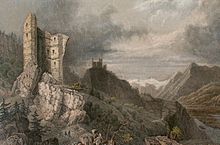Lichtenstein Castle (Haldenstein)
| Lichtenstein Castle | ||
|---|---|---|
|
Lichtenstein Castle above the abyss |
||
| Alternative name (s): | Katzenburg | |
| Creation time : | beginning of the 12th century | |
| Castle type : | Höhenburg, rocky location | |
| Conservation status: | ruin | |
| Standing position : | Free nobles | |
| Construction: | Quarry stone | |
| Place: | Haldenstein | |
| Geographical location | 46 ° 53 '4.2 " N , 9 ° 31' 35" E | |
| Height: | 770 m | |
|
|
||
The Castle Lichtenstein is the ruin of a rock castle above the village of Haldenstein in the Swiss canton of Grisons .
location
Lichtenstein Castle is located on a rocky ridge at 770 m high above the Rhine Valley and is one of the three castles in the municipality , along with Grottenstein Castle and Haldenstein Castle . It can be easily reached in half an hour from the village via a narrow road (no driving). Because of its appearance - the ruin resembles a lying cat - Lichtenstein is also popularly called Katzenburg .
history
Finds show that the place in the natural saddle north of the castle, the so-called Hexenbödeli , was inhabited from the Neolithic to late antiquity . The Lords of Lichtenstein appear in the sources for the first time on June 26, 1180: At that time Henricus de Lihtensten was entered in the Chur Book of the Dead. The castle should have already existed at that time, while the neighboring Grottenstein and especially Haldenstein are a bit younger. In the 12th century the family seems to have split into a Lichtensteiner and a Haldensteiner branch; this can be inferred from the very similar coats of arms of the families.
Already a hundred years later the Lichtensteiners disappeared from the sources: On March 22, 1275, their last secular representative, the knight Ulrich von Lichtenstein, died. A canon Rudolf von Lichtenstein is mentioned for the last time in 1282. The legacy of the Knights of Lichtenstein and their castle now fell to their relatives, those of Haldenstein. There the name Lichtenstein appears as a first name: From 1351 to 1386 a Lichtenstein von Haldenstein is mentioned as the youngest of four brothers in the documents.
The castle was mentioned for the last time in 1396: At that time, after a feud between the Bishop of Chur and Ulrich Brun von Rhäzüns , Anna von Haldenstein and her husband, Christoph von Hertenegg, were reconciled with Brun as episcopal followers. This was recorded in writing at the Liehtenstain on the vesti . Lichtenstein seems to have been abandoned in the 15th century. In 1479 another way is mentioned, the gateway to Liechtenstein , later there are no more indications. There are no signs of violent destruction of the facility. The castle was first described as a ruin around the middle of the 16th century.
In 1622, in the midst of the Bündner turmoil , Lichtenstein was occupied by Alois Baldiron with a force of around 200 men. It should have made it more difficult for the Prättigauers to access the Bündner Oberland, but after three days she ran out of drinking water and provisions. After that, Lichtenstein was finally left to decay. It was not until the 20th century that minor security measures were taken on the masonry.
investment
The remaining wall remains consist of rather small flat rubble stones , many of them in Opus spicatum (corn plant). On the artificially leveled meadow northwest of the ruin there are no more wall remains, but it certainly also belonged to the castle. The original gate that led into the Bering in the northeast was later walled up; a later goal could not be determined.
The three-storey residential wing formed an elongated rectangle with a ground-level round arched door with tuff walls and a wooden lintel on the SE side, which was only accessible via a wooden structure (which has since disappeared). Today the door leads straight into the abyss. A vertical joint in the NW wall indicates a subsequent expansion of the building. There are no traces of an internal subdivision of the wing. Inside the residential wing there is a well-preserved tank cistern with a rectangular floor plan, a vaulted ceiling and brick shot plastering.
literature
- Thomas Bitterli-Waldvogel: Swiss Castle Guide . Basel / Berlin 1995
- Werner Meyer : Castles of Switzerland. Volume 3 . Zurich 1983
- Otto P. Clavadetscher, Werner Meyer: The castle book of Graubünden . Zurich / Schwäbisch Hall 1984
- Fritz Hauswirth: Castles and Palaces of Switzerland. Volume 8 . Kreuzlingen 1981
- Georg Lütscher: History of the Freiherrschaft and municipality Haldenstein . Haldenstein





